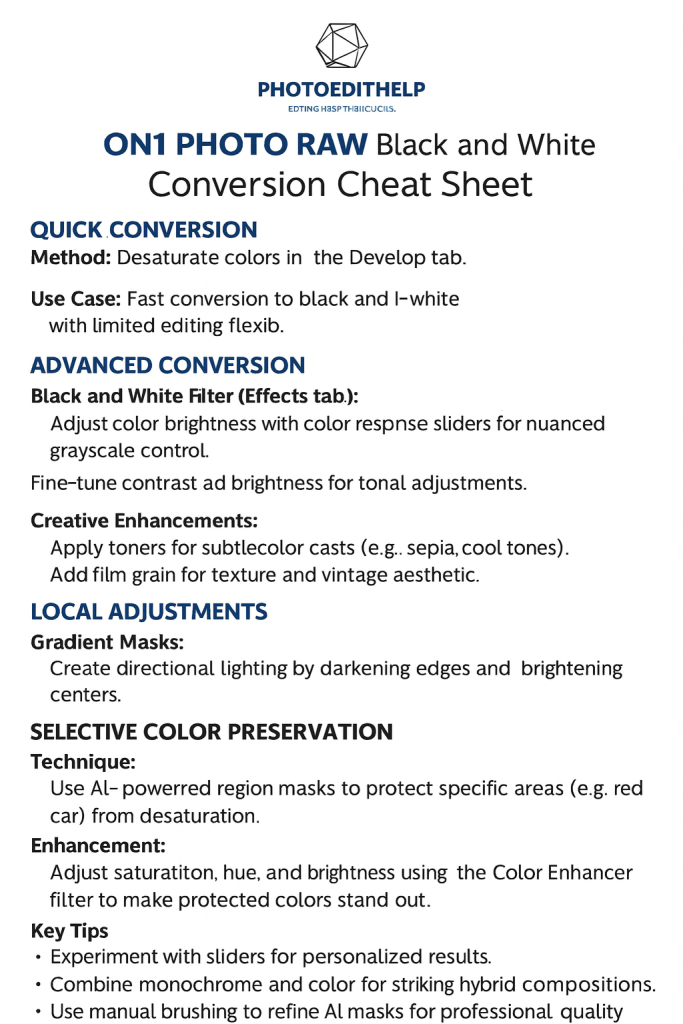Summary
This video tutorial provides a comprehensive guide on converting images to black and white using On1 Photo RAW, emphasizing both quick methods and advanced techniques for precise control over the conversion process. The instructor first demonstrates the simplest way to convert images by desaturating colors in the Develop tab, offering a fast path to black and white but limited editing flexibility. For more refined control, the video introduces the Black and White filter found in the Effects tab, which allows detailed manipulation of color brightness before conversion, tonal adjustments like contrast and brightness, and creative enhancements such as toners and film grain to add texture and mood.
The tutorial also highlights the use of LUTs (Lookup Tables) as an alternative route to applying black and white styles, with numerous presets available out of the box or downloadable from the On1 creative library. Beyond global adjustments, the instructor explores local adjustments using gradient masks to add directional lighting effects that enhance composition and focus within the image. This local lighting approach helps create dynamic contrast and reduce distractions in peripheral areas.
A powerful feature covered is the targeted masking capability, which allows users to selectively preserve color in specific parts of an image while converting the rest to black and white. Using AI-powered region masks and manual brush work, the tutorial shows how to protect subjects like a red car from desaturation, enhancing visual impact by combining monochrome and color elements. The final step involves fine-tuning the protected color’s saturation, hue, and brightness using the Color Enhancer filter to make it stand out vividly against the monochrome background.
Throughout the lesson, the instructor encourages experimentation with sliders and masking tools to create personalized black and white images that express artistic vision and mood. The video concludes with a recap of the techniques and an invitation to subscribe for more editing tutorials using On1 Photo RAW.
Highlights
- Quick black and white conversion by desaturating colors in the Develop tab.
- Use the Black and White filter for precise control over color brightness and tonal adjustments.
- Add creative toners and film grain for texture and mood in black and white images.
- Use LUTs filters to apply various black and white styles instantly.
- Apply local adjustments with gradient masks for dynamic directional lighting.
- Selectively preserve color in specific subjects with AI masking and manual brush refinement.
- Enhance protected colors with saturation, hue, and brightness adjustments for visual impact.
Key Insights
- Complete control via Black and White filter: Unlike simple desaturation, the dedicated Black and White filter in On1 Photo RAW offers color response sliders that adjust the brightness of individual colors within the image. This nuanced control allows photographers to emphasize or suppress specific hues when converting to grayscale, enabling more artistic and customized black and white renditions that better reflect the scene’s mood and composition.
- Creative toners and film grain enrich monochrome images: Adding toner overlays introduces subtle color casts to black and white images, which can evoke different aesthetic styles such as sepia or cool tones. Film grain adds a tactile, vintage quality that enhances the image’s perceived authenticity and atmosphere. These features demonstrate that black and white photography isn’t limited to flat grayscale but can be creatively manipulated for emotional and stylistic depth.
- LUTs provide fast and flexible preset options: LUTs are powerful for users who want to quickly experiment with different black and white looks without manually adjusting multiple sliders. On1 Photo RAW’s built-in LUT library and downloadable creative resources expand creative possibilities, making it easy to apply professional-grade black and white effects with minimal effort. This is particularly useful for batch processing or for photographers seeking inspiration.
- Directional lighting through local adjustments adds depth: Using reflected gradient masks to darken edges and brighten the center draws the viewer’s eye to key areas, improving composition and visual interest. This technique mimics natural lighting and can enhance the dramatic feel of black and white images by increasing contrast and reducing distracting peripheral elements, thereby turning a flat image into a more compelling visual story.
- Selective color protection emphasizes key subjects: The ability to mask out specific objects from the black and white filter while converting the rest of the image is a powerful creative tool. This selective color approach helps highlight important elements, like a bright red car, creating striking contrasts and directing the viewer’s attention. This technique bridges color and monochrome photography, allowing hybrid compositions that stand out in portfolios and social media.
- Manual brush refinement ensures precise masking: While AI region masks do much of the heavy lifting in selecting subjects, manual brushing is essential for fine-tuning details such as windows or tires where automatic masks might include unwanted areas. This combination of AI and manual input provides both efficiency and precision, enabling professional-quality masking results that maintain the integrity of the subject and the overall image.
- Color enhancement after masking deepens impact: After protecting the color in a subject, adjusting saturation, hue, and brightness using the Color Enhancer filter further refines the visual appeal. Darkening reds or increasing vibrance can make the subject pop against the desaturated background, reinforcing its importance and adding richness. This demonstrates how black and white editing workflows can still engage with color theory to maximize emotional and aesthetic resonance.
In summary, this tutorial not only teaches the mechanics of black and white conversion in On1 Photo RAW but also introduces advanced creative strategies that enhance photographic storytelling through tonal control, texture, lighting, and color emphasis. It empowers photographers to produce custom monochrome images that are technically refined and artistically compelling.

